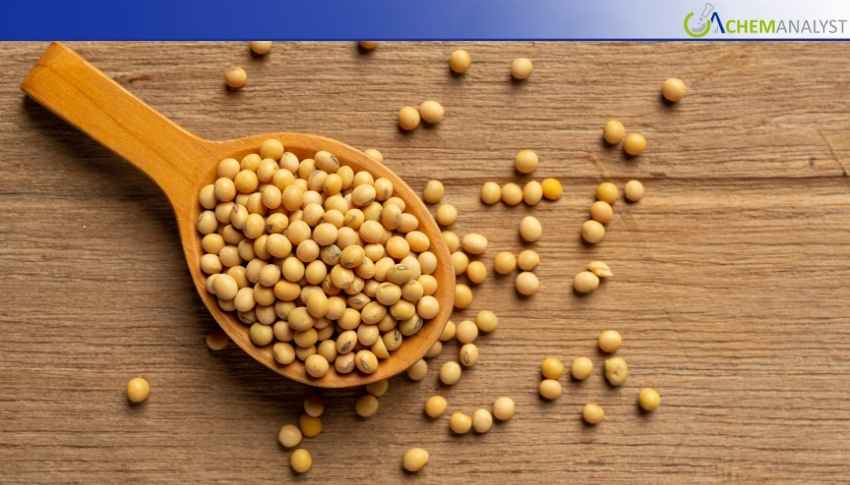Welcome To ChemAnalyst

Europe Soya Lecithin in September 2025, the European market for Soya Lecithin price is reported to decrease at the rate of -2.4%, reverting its flattening trend witnessed in recent months. This was due to the supply being abundant and the demand not being strong, which formed a buyer’s market. A record Soy crop in large producing nations (U.S., Brazil, and Argentina) resulted in additional soybeans & Soya Lecithin left over, placing price pressure on suppliers. This was attributed to sluggish demand from food and beverage manufacturers as well as post-summer manufacturing deceleration and reluctant purchase patterns. Buyers also explored alternative emulsifiers such as Sunflower Lecithin. Prices were also weighed down by macroeconomic issues around inflation, currency fluctuations, and trade uncertainty. Nevertheless, analysts expect a recovery in Q4 2025 amid seasonal demand when holiday season food production boosts soybean demand and zones cease grinding the soy crop. Supply cuts, factory re-starts, and potential currency stability could help prices rebound. Despite competition from alternatives, Soya Lecithin still leads the emulsifier market because of its value for money and performance.
In September of 2025, the European Soya Lecithin market continued the trend observed in previous months when a softening of prices was recorded with a decline of 2.4%. The decline in prices was attributed to a combination of supply and demand factors. Soya Lecithin is a versatile emulsifier found in a wide range of food, pharmaceutical, and industrial applications. Prices declined further due to ample supply with a bearish demand trend, resulting in a buyer’s market.
At the beginning of the month, the harvest season was underway in the major soy-producing areas of the United States, Brazil, and Argentina, with a bumper soy crop, which contributed to excess soybeans and thus excess Soya Lecithin, the main raw ingredient. In turn, processing companies moved quickly to produce Soya Lecithin in anticipation of the excess quantity of soybeans being shipped into the market. This operation led to a surplus inventory being available, which created further competitive tension among suppliers as they endeavored to rid themselves of excess inventory by lowering their pricing.
Demand for Soya Lecithin continued to be weak in the month of September, which was particularly true for food and beverage producers who are significant consumers of Soya Lecithin. The weak demand was compounded by a post-summer slowdown in manufacturing and a cycle of caution by food processors in their buying habits.
Numerous producers postponed buying strategies due to expecting more price realignments, and various buyers also evaluated new emulsifier sources such as Sunflower Lecithin to develop their supply chains. Pharmaceutical manufacturing, as another major user of Soya Lecithin, witnessed a temporary slowdown in production, which also reduced demand. Other macroeconomic uncertainty, such as inflationary pressures and the coin’s valuation, increased buyers' cautious sentiment and waiting-and-seeing sentiment rather than making large volume purchases.
In addition, the ongoing effects of uncertainties in trade policy and logistics prevented some buyers from being aggressive with their procurement, all of which added to the downward pressure on prices. The continuing interest in alternative emulsifiers also added to the decline of Soya Lecithin prices, as food manufacturers looked to place-based substitutes given the demand for clean labels and sustainable ingredients.
While the outlook is bearish for September, industry analysts expect some improvement in the near term in the price of Soya Lecithin. An ordinary seasonal rise in demand is observed in Q4, and arises from holiday preparation in the larger markets. The food industry, notably, will be busy increasing production of confectionery, bakery, and processed foods, which utilize Soya Lecithin as an emulsifier. This seasonal increase in demand will likely help alleviate the oversupply of inventory from September and provide some stimulus to prices. Lastly, the end of the soy crop in the primary growing areas should help further constrain the supply of raw soybeans, bringing supply back in line with demand.
Adjustments in supply and possible volume cuts are also expected to support price recovery. With processor supply aligning with demand forecasts, the oversupply situation should be alleviated. Any transport or processing disruptions will only limit supply and put upward price pressure. The pharmaceutical and industrial sectors are also expected to recover in Q4 2025 with production cycles resuming at a steady rate. This new growth period for industrial activity will drive demand for Soya Lecithin, and overall prices should gradually firm.
We use cookies to deliver the best possible experience on our website. To learn more, visit our Privacy Policy. By continuing to use this site or by closing this box, you consent to our use of cookies. More info.
